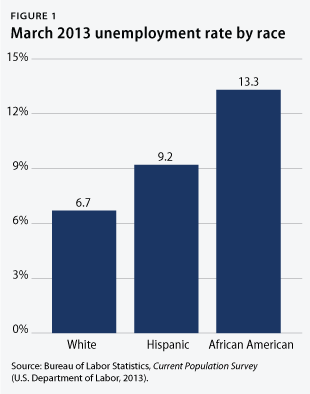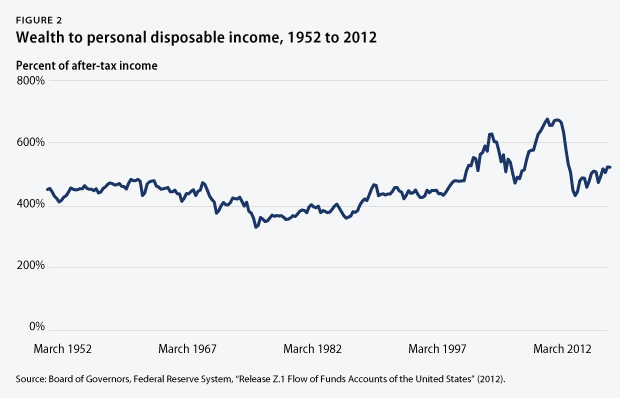Doubts remain about the strength of the economic recovery even in the fourth year of the economic expansion that officially started in June 2009. Most importantly, job growth slowed again in March 2013 after gaining some strength in the preceding months. The economic recovery should be self-sustaining at this point, but large, persistent problems such as massive household-debt burdens, high U.S. income inequality, and public fiscal problems both in the United States and overseas are holding back economic and job growth.
As a result, the U.S. economy will require continued policy attention to generate the much-vaunted self-sustaining momentum. Infrastructure investments, for example, would help create more private-sector jobs in the short run and lay the foundation for faster growth in the long term by lowering the cost of doing business, thereby making America more competitive globally. A higher minimum wage, in addition, would be a first step in attacking the massive income inequality in the United States, as it would ease the financial struggles of those households with the lowest incomes. And policymakers can do more to help households with outstanding mortgages refinance their debt into lower-interest mortgages to ease the still relatively large debt burden. The modest recovery will still require additional policy interventions to accelerate economic growth and, even more importantly, job creation.
1. Economic growth slowed markedly at the end of 2012. Gross domestic product, or GDP, was essentially flat in the fourth quarter of 2012, increasing slightly at an annual rate of 0.4 percent. Domestic consumption increased by an inflation-adjusted annual rate of 1.8 percent; housing spending grew by 17.6 percent; and business investment accelerated by 13.2 percent. In the fourth quarter of 2012, however, exports fell by 2.8 percent, and government spending shrank by 7 percent. Policy solutions should therefore aim to ease the strain of fiscal austerity on the economy by dampening spending cuts, and they should boost domestic private-sector economic activity to offset the fall-off in overseas demand.
2. The moderate labor-market recovery continues in its fourth year. There were 4.6 million more jobs in March 2013 than in June 2009 when the economic recovery officially started. The private sector added 5.3 million jobs during this period. The loss of nearly 687,000 state and local government jobs explains the difference between the net gain and the private-sector gain in this period, as budget cuts reduced the number of teachers, bus drivers, firefighters, and police officers, among others. Job creation should be a top policy priority since private-sector job growth is still too weak to quickly overcome other job losses and rapidly lower the unemployment rate. Once again, removing the uncertainty about fiscal changes is a key step toward strengthening economic and job growth.
3. Long-term unemployment remains high. The unemployment rate stood at 7.6 percent in March 2013. Long-term unemployment—defined as people who are out of work and have been looking for a job for more than six months—also remained high. In March 2013, 39.6 percent of the unemployed were considered long-term unemployed. The average length of unemployment also grew slightly in March 2013, rising to 37.1 weeks. Those out of a job for a long time struggle to regain employment because their skills atrophy and entry into a new job becomes increasingly harder. The continuation of extended unemployment insurance benefits as part of the resolution to the fiscal showdown on January 1, 2013, was thus a welcome policy that helped many of those most vulnerable to economic shocks.

4. Labor-market troubles fall especially hard on communities of color, young workers, and Americans with less education. The African American unemployment rate in March 2013 was 13.3 percent; the Hispanic unemployment rate was 9.2 percent; and the white unemployment rate was 6.7 percent. The population groups with higher unemployment rates—those that typically also have low incomes and little wealth—have struggled disproportionately more amid the weak labor market than white workers, older workers, and workers with more education. This creates a greater need for progressive policy actions to strengthen job creation for everybody. Meanwhile, youth unemployment stood at 24.2 percent. The unemployment rate for people without a high school diploma ticked down slightly to 11.1 percent—compared to 7.6 percent for those with a high school degree, 6.4 percent for those with some college education, and 3.8 percent for those with a college degree.
5. Household incomes continue to drop amid prolonged weaknesses in the labor market. Median inflation-adjusted household income stood at $50,054 in 2011—the most recent year for which data are available—its lowest level in inflation-adjusted dollars since 1995. Median income fell by 1.5 percent in 2011, dropping for the fourth year in a row. American families as a whole have experienced no income gains during the current economic recovery since 2009, exacerbating the losses that occurred during the Great Recession.
6. Income inequality on the rise. Incomes of households in the 95th percentile—with incomes of $186,000 in 2011—were more than nine times the incomes of households in the 20th percentile, whose incomes were $20,262. This is the largest gap between the top 5 percent and the bottom 20 percent of households since the U.S. Census Bureau started keeping record in 1967.
7. Poverty stays high. The poverty rate fell to 15 percent in 2011, down from 15.1 percent in 2010. The African American poverty rate was 27.6 percent; the Hispanic poverty rate was 25.3 percent; and the white rate was 9.8 percent. The poverty rate for children under the age of 18 stood at 21.9 percent. More than one-third of African American children—38.8 percent—lived in poverty in 2011, compared to 34.1 percent of Hispanic children, and 12.5 percent of white children. The prolonged economic slump, following an exceptionally weak labor market before the crisis, has taken a massive toll on the most vulnerable citizens.
8. Employer-sponsored benefits are disappearing. The share of people with employer-sponsored health insurance dropped from 59.8 percent in 2007 to 55.1 percent in 2011, the most recent year for which data are available. The share of private-sector workers who participated in a retirement plan at work fell to 39.2 percent in 2011, down from 42 percent in 2007. Families now have less economic security than in the past due to fewer employment-based benefits, which requires more private savings to make up the difference.
9. Family wealth losses still linger. In December 2012 total family wealth was down $8.4 trillion—in 2012 dollars—from its last peak in March 2007. Homeowners on average own only 46.6 percent of their homes—compared to the long-term average of 61 percent before the Great Recession—with the rest owed to banks. Homeowners’ massive debt slows household spending growth, as households still do not have a lot of collateral for banks to loosen their lending standards, and households spend less than they otherwise would on new homes and on other large-ticket items.

10. Household debt is still high. Household debt equaled 105.5 percent of after-tax income in December 2012, down from a peak of 126 percent in March 2007. The unprecedented fall in debt over the past few years is a result of tighter lending standards, falling interest rates, massive foreclosures, and increased household saving. But unless incomes rise faster than they have in the past, further deleveraging will likely slow since most factors that helped reduce household debt in the past have slowed or disappeared, such as falling interest rates and the payroll tax holiday. This high debt could continue to slow economic growth, as households focus on saving rather than on spending.
11. The housing market continues to recover from historic lows. New home sales amounted to an annual rate of 411,000 in February 2013—a 12.3 percent increase from the 339,000 homes sold in February 2012, but well below the historical average of 698,000 before the Great Recession. The median new home price in February 2013 was 2.9 percent higher than one year earlier. Existing home sales were up by 10.2 percent in February 2013 from one year earlier, and the median price for existing homes was up by 11.6 percent during the same period. The housing market could potentially grow and contribute to economic progress because the recovery in the spring of 2012 started from historically low home sales, and the housing market fell throughout most of the recovery. The fledgling housing recovery could gain further strength if policymakers focus on personal income gains in the near term.
12. Homeowners’ distress remains high. Even though mortgage troubles have gradually eased since March 2010, nearly one in nine mortgages are still delinquent or in foreclosure. In the fourth quarter of 2012, the share of mortgages that were delinquent was 7.1 percent, and the share of mortgages that were in foreclosure was 3.7 percent. Many families delayed and defaulted on mortgage payments amid high unemployment and massive wealth losses. This caused some banks to be nervous about extending new mortgages, which further prolonged the economic slump. Policymakers can accelerate economic growth by helping households lower their debt burdens through refinancing help and debt forgiveness.
13. Corporate profits stay high near precrisis peaks. Inflation-adjusted corporate profits were 85.2 percent larger in December 2012 than in June 2009, when the economic recovery started. The after-tax corporate profit rate—profits to total assets—stood at 3.1 percent in December 2012, nearing the previous peak after-tax profit rate of 3.2 percent that occurred prior to the Great Recession.
14. Slow productivity growth marks the U.S. economy. Productivity growth is the main ingredient in rising living standards since wages, jobs, and profits depend on workers and companies figuring out how to make more and better things in the same amount of time. Output per hour, the main measure of productivity growth, has expanded by only 7.3 percent from December 2007 when the Great Recession started to December 2012, the last quarter for which data are available. This is substantially less than the average productivity growth of 8.9 percent during the same periods in previous business cycles of equal or greater length.
Christian E. Weller is a Senior Fellow at the Center for American Progress and a professor in the Department of Public Policy and Public Affairs at the McCormack Graduate School of Policy and Global Studies at the University of Massachusetts Boston. Sam Ungar is a Special Assistant at the Center.